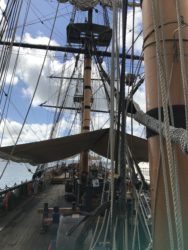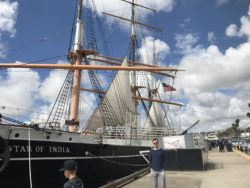
If you lived in the age of the explorers, would you have had the courage to sail across the ocean on a ship like this one? I toured the Maritime Museum of San Diego on our trip to California last week, and as I stood on the deck of the San Salvador, a replica of a Spanish Galleon from 1542, I asked myself that question.

The ship is less than 100 feet long and only 32 feet wide, and seemed much too small to cross the Atlantic Ocean from Spain, travel around the tip of South America to the Pacific Ocean, and then sail up the California coast. But that’s exactly what the early explorers did as they sailed to the New World.

Or how about setting sail on this ship, the Star of India? It was also on display at the museum, and carried passengers from Great Britain to New Zealand in the mid-1800s. That voyage around the southern tip of Africa lasted five months! I tried to imagine being stuffed into the cramped space below deck with my entire family in stormy seas, and wondered what drew people to immigrate to new lands at such great risk.

We also toured the California Science Center in Los Angeles where the space shuttle Endeavour is on display. What amazing courage it must take to embark on such a voyage! I can say with certainty that a trip to outer space isn’t for me. I had to endure an hour and a half of stomach-churning turbulence on our flight home from California and that was adventure enough!
So why are some people willing to “boldly go where no man has gone before” as they used to say on the TV series Star Trek? Where does that adventurous spirit come from? I once heard a rabbi speak on the creation story in Genesis and he had an interesting interpretation of the verse where God commands Adam and Eve to fill the newly-created earth and “subdue” it. The rabbi believed that subduing the earth means we’re supposed to use our natural curiosity and sense of adventure to explore the world and learn everything we can about it, much like my one-year-old granddaughter who toddles around the backyard wide-eyed, examining every leaf and stick and ant with a sense of wonder. It’s part of our nature to continue to learn and grow, to explore new places, and challenge ourselves to try new things. But as we get older we become conditioned by fear and our desire for comfort, and so we set aside our natural curiosity to remain “safe.”
If I’m not careful, I can lose that sense of newness and awe in my spiritual life, as well, and become what Eugene Peterson calls a mere “spectator and consumer” rather than an actively growing Christian. In his wonderful book about the life of Jeremiah entitled “Run With the Horses,” Peterson says: “The aim of the person of faith is not to be as comfortable as possible but to live as deeply and thoroughly as possible—to deal with the reality of life, discover truth, create beauty, act out love.” That sounds very dangerous and risky, doesn’t it? Like crossing the ocean in a flimsy schooner or being launched into space. But in order to truly love others as Christ does, it’s going to require fearlessness and risk-taking. We may have to leave our comfort zone and reach out to people who aren’t like us.
And yet if I trust Jesus’ promise that He will never leave me or forsake me, shouldn’t I be fearless? Shouldn’t I be willing to risk going boldly through life, dealing with its realities, living deeply, loving others? Will I be as courageous as the early explorers or prefer to remain safe, becoming a spiritual “spectator and consumer?” Peterson also says, “The only opportunity you will ever have to live by faith is in the circumstances you are provided this very day.”
As you and I look around at the circumstances we find ourselves in today, are we willing to step out boldly and live by faith? Jesus said, “I tell you the truth, if you have faith as small as a mustard seed, you can say to this mountain, ‘Move from here to there’ and it will move. Nothing will be impossible for you.” Let’s move some mountains today!


